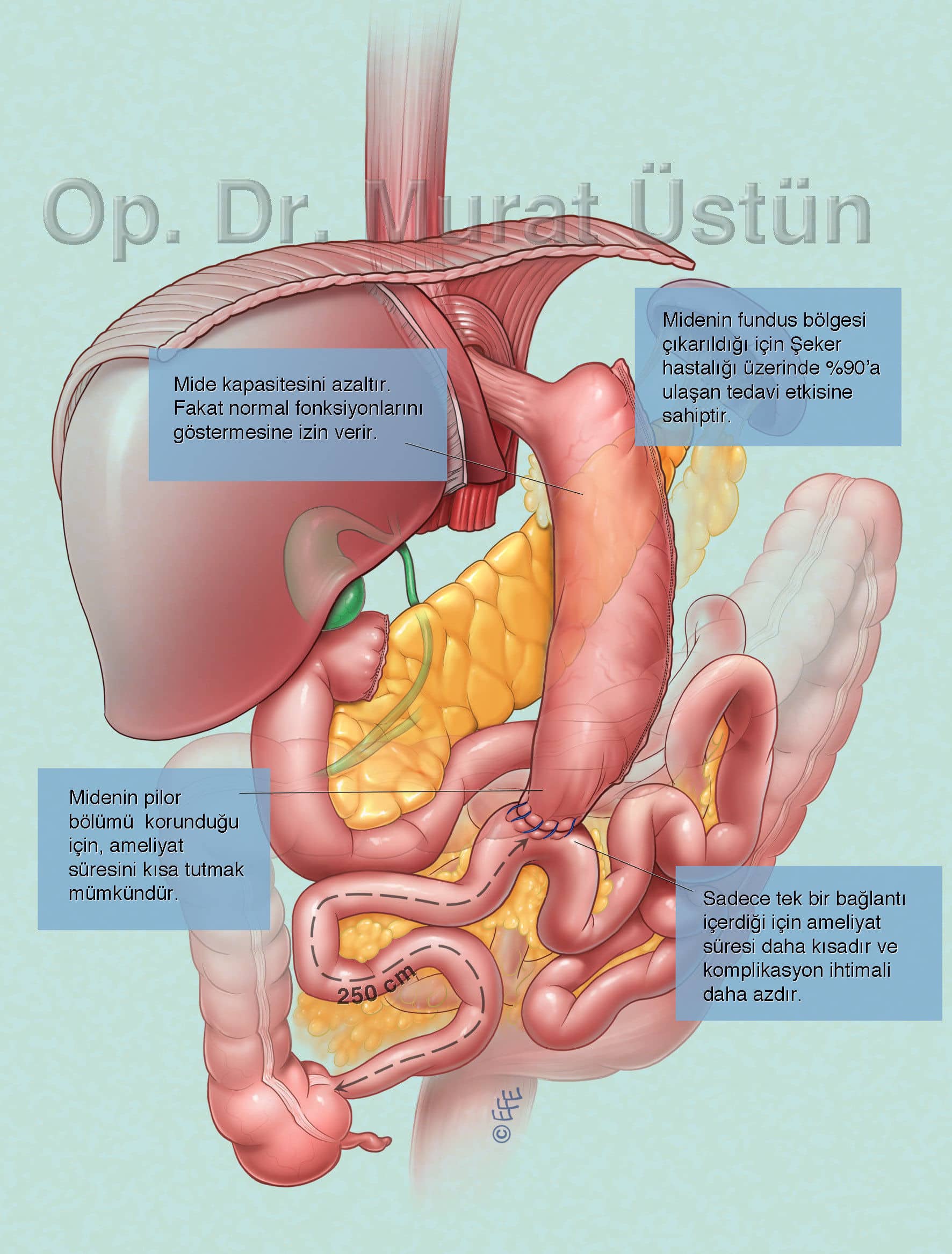Duodenal Switch (DS) Surgery
Duodenal switch surgery, also known as ‘biliopancreatic diversion with duodenal switch’, is a surgical procedure that has been performed for a long time. SADI-S (Single Anastomosis Duodeno-Ileal Bypass with Sleeve Gastrectomy) is a more up-to-date and safer version of this highly effective surgical procedure.
Like gastric bypass, SADI-S is a surgical procedure having both restrictive and absorption-reducing effects. This procedure, also known as ‘loop duodenal switch surgery’, is highly effective with its restrictive and absorption-reducing effects on weight loss and the resolution of certain problems, particularly diabetes.

How is Duodenal Switch Surgery Performed?
The first stage of surgery involves removing 85% of the stomach, in such a way as to form the stomach into a tube shape, as in sleeve gastrectomy, i.e. gastric sleeve surgery. This segment creates an effect that restricts food intake. In the second stage, the duodenum is removed by making a cut at point a few centimeters ahead of the sleeve-shaped muscle layer called the pylorus at the gastric outlet; and another cut a little behind the point where bile and pancreas fluids are poured. The gastric outlet is anastomosed to a small intestine segment located 250 cm behind the junction of the small and large intestines. In other words, the length of the intestine allowing for absorption, where the bile acid and other digestive enzymes are mixed with foods, is reduced to 250 cm. This process reduces the absorption amount of fat and calories in foods to a value higher than that achieved with gastric bypass.
What is the Difference of the current SADI-S Surgery from the Traditional Duodenal Switch?
In traditional DS surgery, almost 80% of the small intestine of a person is bypassed. In this surgery, considerable weight loss is achieved; however, patients experience a serious vitamin, mineral, and protein malnutrition, despite the supportive treatment. In SADI-S surgery, approximately 80% of the small intestine is bypassed. Leaving an adequate length of small intestine minimizes the vitamin-mineral absorption deficiency, but on the other hand, the weight loss effect is maximized.
Especially if you consider having this surgery due to some reason such as uncontrolled diabetes, you must know that you will need to follow a strict follow-up schedule and take vitamin-mineral supplements in the rest of your life. However, we can say that SADI-S is an extremely effective and safe procedure as long as you meet these requirements.
What Should I Expect After SADI-S?
SADI-S surgery combining the effect of restricting food intake and absorption-reducing effect is one of the bariatric surgery procedures that provides the greatest amount of weight loss. Most patients can lose 80-100% of their excess weight within 9 months. SADI-S is also one of the surgical procedures that give the strongest results in the elimination of Type 2 diabetes. Other metabolic comorbidities such as hypertension, sleep apnea, and elevated cholesterol are also considerably corrected very quickly. The most significant side effect is frequent malodorous diarrhea encountered in the early postoperative period. This side effect gradually subsides after the intestinal adaptation process.
How are Follow-Ups Conducted SADI-S?
Your first check will be done at our clinic in the first postoperative week. During that visit, you will be evaluated in terms of both fluid consumption and acute complications (if needed). The subsequent controls will be done in the 1st-3rd-6th-12th-18th- and 23rd months, with the evaluation of the required biochemical tests. In this process, our dietitian and bariatric surgery team will program your endocrinological follow-up. If any specific vitamin-mineral deficiency is found in the tests, your treatments will be arranged accordingly. A multidisciplinary team work will be conducted to make your eating habits permanent, and enable you to lose weight and maintain your new weight healthily. If our patients living abroad have their routine tests performed and send us their results, their general medical conditions, health indicators and weight losses are followed-up, as long as they have no complaints. In these processes, online video conferences with our surgical team, dietician, endocrinologist and psychiatrist via Skype will also be organized, and information will be shared via online seminars for enabling you to experience the process comfortably as much as possible.
Am I Eligible for SADI-S?
If you have a body mass index (BMI) of 50 or greater, especially if you have uncontrolled diabetes that requires you to use insulin, and if you can meet the requirements of lifelong follow-up and vitamin use, you can be eligible for SADI-S?
Who are not Eligible for SADI-S?
If you currently have deep vitamin mineral deficiencies (such as anemia associated with iron deficiency), if you have Crohn’s disease or any chronic diseases that require you to use cortisone, if you have a story of large intraabdominal surgery, if you have intestinal disorders that cause diarrhea such as irritable bowel syndrome, and if you have severe reflux (in 20% of patients, an increased reflux has been reported) you may not be eligible for SADI-S.
